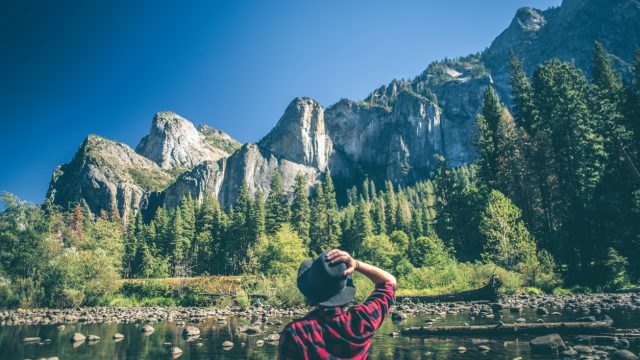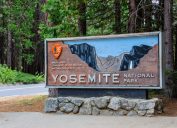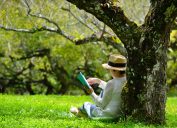Yosemite National Park Officials Say If You Hear This, "Quickly Get Away From the Area"
They're reminding visitors to be aware of this seasonal hazard.
A trip to Yosemite National Park can be pleasing to all of the senses. After all, it's the sight of incredible mountain views, the smell of fresh air, and the feeling of the breeze that draw so many people to visit the park each year. But no matter where you are, any trek into nature comes with its own risks that your senses can also help you avoid—including your hearing. And now, officials at Yosemite are warning guests to "quickly get away from the area" if they hear this one thing. Read on to find out what sound could mean you're in danger.
READ THIS NEXT: The 6 Best U.S. National Parks to See Fall Foliage.
Yosemite has struggled with major wildfires this summer.

This summer has been particularly difficult for Yosemite as it dealt with two major wildfires that forced portions of the park to close and nearby residents to evacuate. The Washburn fire started on July 11, eventually spreading and threatening the park's famous giant sequoia trees in the Mariposa Grove before crews finally extinguished it on Aug. 1. The conflagration burnt 4,886 acres before it was put out, according to reports from state officials. The Oak fire that began on July 22 continues to burn and has affected 19,244 acres to date but is 98 percent contained as of Aug. 16, per officials.
In response to the immediate threat the wildfires pose to Yosemite's beloved forests, officials ironically used a method of cutting down specific trees to help control the blaze and limit the damage, The New York Times reported. The program helps to mitigate conditions by "felling" trees smaller than 20 inches in diameter or any that have died, while also pulling fallen timber and logs from the forest floor to stop the fire from spreading.
"It hurts people's hearts," Cicely Muldoon, superintendent at Yosemite National Park, told The Times. "But we have to use every tool at our disposal to save the forests and to save the park and to restore a healthy ecosystem and to keep people safe."
And now, conditions at the park have created another potential hazard for park guests.
Yosemite officials are warning visitors to "quickly get out of the area" if they hear this sound in the park.
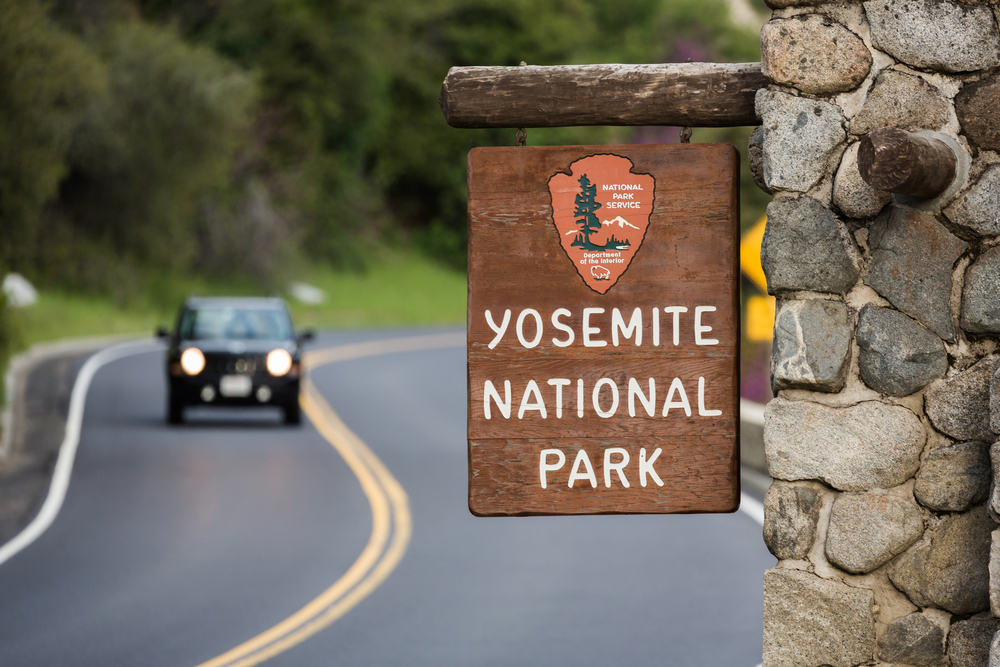
The warmer months may be peak visitation time for national parks, but the same seasonal conditions that make wildfires a concern also bring about another safety issue. In a post on the park's official Facebook page on Aug. 12, officials alerted the public that trees in Yosemite were experiencing "summer branch drop" (SBD). They say the relatively common event occurs on hot, still days, and while scientists aren't sure of the root cause, it's believed that a combination of the buildup of moisture within branches and dry soil conditions causes branches to fall without warning.
"Cooling off underneath an oak tree is one of the greatest pleasures after a long trek in the summer sun. However, a delightful picnic or siesta in the shade can be dangerously disrupted by summer branch drop," the post reads.
And while there can be little time to react, officials say one audible warning should be reason to get up and leave. "If you hear a loud crack from a tree, quickly get away from the area," the post urges.
For more travel alerts sent right to your inbox, sign up for our daily newsletter.
There have been recent incidents where park visitors have been injured or worse by the seasonal hazard.

While many park visitors may assume the greatest danger is encountering a wild animal, few realize it's trees that can become a hazard. And recent incidents have shown that many are taken off guard when that happens.
In 2017, two Yosemite visitors were seriously injured when a large branch fell onto their vehicle that had stopped under a tree, local affiliate FOX26 reported. And in 2015, two young campers were tragically killed when a large limb from an oak tree fell onto their tent while they were sleeping at a campground, the Los Angeles Times reported.
Others have reported near misses. During a camping trip last summer, Yosemite visitor Kathi Andrews says she had just returned to her cabin after visiting the restrooms with her grandson when "the most tremendous cracking and crashing sound" took her by surprise.
"I actually put my hands up over my head because the sound was so near," Andrews told local Bay Area news outlet SFGate. "I heard screams from the other campers."
When she investigated the noise, she discovered that a large oak branch had fallen across the path she had just passed through minutes earlier. "It was incredible!" she told the news outlet. "In the morning, the enormity of our close call took my breath away."
There are a few ways to reduce your risk of being hit by a fallen branch at Yosemite—and elsewhere.
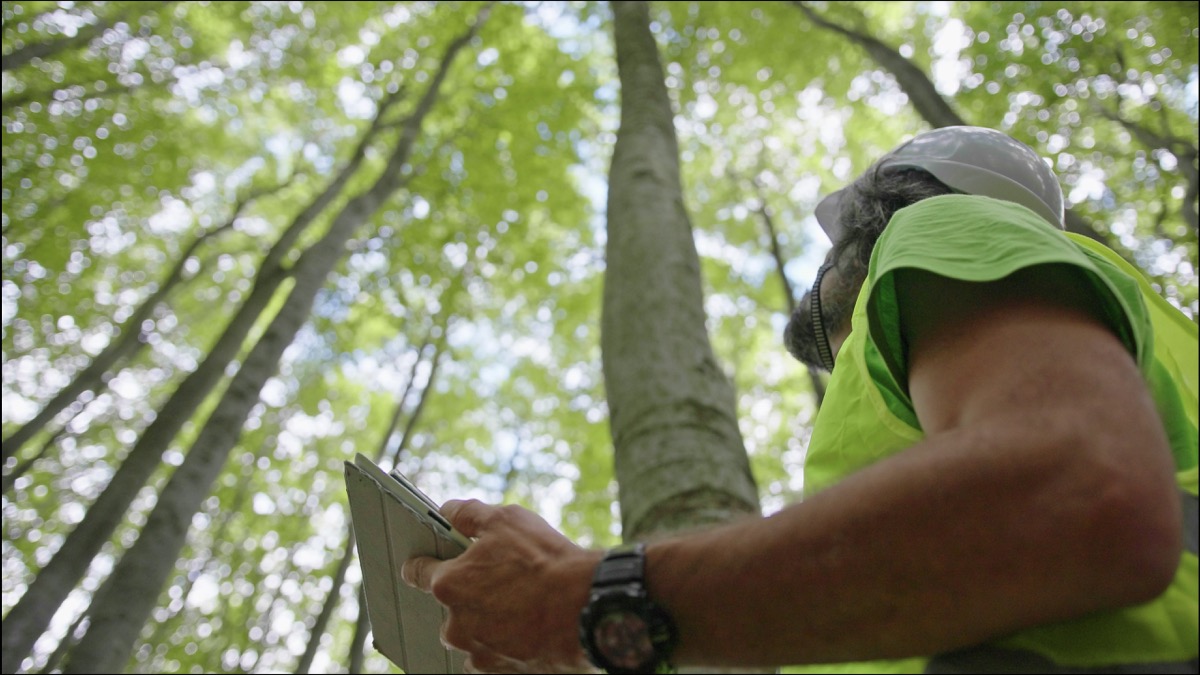
Of course, running from the cracking sound of a falling branch is a last-second method of avoiding injury. But Yosemite officials say that you can proactively avoid the branch hazard by keeping away from the park's California black oak trees—which are most prone to SBD—and keeping your surroundings in mind when you begin settling in.
"Generally, it is a good idea to avoid sitting or setting up a tent directly underneath large oak branches," the Facebook post advises. "Be aware of your surroundings and do not leave immobile people, such as infants or the elderly, directly under large oak trees."
Some visitors have already decided to put the advice into practice. "You better believe that when we camp in Yosemite next week, we will be steering clear of oak trees," Andrews told SFGate.
